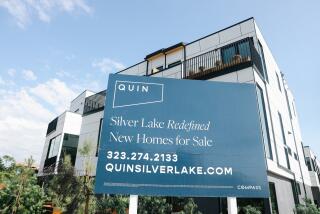Homeowners’ big question: How low will prices go?
![WAITING IT OUT: Eric Broida is interested in buying a nearby house, but doesnt plan on doing so until the asking price drops another $400,000. The price has already been cut several times by the sellers, from the original $4.6 million to $3.6 million. Broida, above, at his Pacific Palisades home. People tell me Im crazy [to think prices will keep falling], but thats what they told me in 1992, he says.](https://ca-times.brightspotcdn.com/dims4/default/7dd21c7/2147483647/strip/true/crop/500x280+0+0/resize/1200x672!/quality/75/?url=https%3A%2F%2Fcalifornia-times-brightspot.s3.amazonaws.com%2Fac%2F6a%2Ff12f137a0cdbc68209a9b9f5dcec%2Fla-fi-howlow-photo)
Eric S. Broida wants to trade up. He has been eyeing a multimillion-dollar house near his Pacific Palisades home and thinks it might be a bargain. Eventually, that is.
The 4,600-square-foot house has languished on the market for six months. The sellers have cut the asking price several times, slashing it from $4.6 million to $3.6 million.
When the price falls by an additional $400,000 or so, Broida will be ready to pounce.
“There is nowhere to go but down from here,” said Broida, a leasing broker for office space. “I know it in my gut.”
Few would argue. Southern California home prices have fallen for five straight months, according to data released this month, and are now down 12% from their peak last spring and summer.
For most of this decade, skyrocketing home values were a frequent topic whenever people gathered along soccer sidelines or at backyard barbecues. But the conversation has taken an about-face, noted Jeff Vendley, a Ventura mortgage broker who is trying to sell two Oxnard town houses he bought in 2004 and 2005.
Now, he said, people are wondering, “How low we can go?”
No one knows how severe the slump will be, but economists and real estate experts interviewed by The Times, and who were willing to make predictions, said prices could fall 15% to 25% before turning back up.
Most said values would continue falling through at least next year, and some thought the market wouldn’t reverse course until 2010.
That could translate to big declines for home buyers who bought at the peak of the market, which various measures place in late 2006 or early 2007.
For example, a home that sold for $800,000 in 2006 could fall to $600,000 over the next two years.
Some analysts, including UC Berkeley professor Kenneth Rosen, believe the severity of the downturn will vary by region.
Areas such as the Central Valley and the Inland Empire will be the hardest hit, he said, because these attracted a higher percentage of new buyers with shaky credit, and many of them are now defaulting on their loans. He believes values in these communities could fall by 15%.
But “in areas where there is very little new housing, where it’s hard to build and a lot of wealthy people live, there will be little decline or maybe none at all.”
So far, the monthly home sales figures appear to bear that out. Last month, for example, median home values fell 15.1% in Riverside County but only 3.8% in Los Angeles County, according to DataQuick Information Services.
Delores A. Conway, director of USC’s Casden Real Estate Economics Forecast, agrees with Rosen, pointing out that demand remains high in affluent, established areas such as the Westside and Newport Beach.
Because there is limited opportunity for new development in these areas, she said, properties are likely to retain their values.
But others call this wishful thinking, saying low prices eventually work their way to even the most affluent areas.
“Every place takes the hit in the long run,” said Christopher Thornberg of Beacon Economics, a consulting firm in L.A.
If prices in high-end markets do not bend while prices fall in adjacent areas, many buyers will at some point choose the cheaper neighborhood, he said.
“If the gap between Riverside and Orange County becomes too great, a person will say, ‘Forget it, I’m not going to live in Orange County,’ ” he said. “If prices get too high in Beverly Hills, it drives demand to Santa Monica.” Such movement eventually drags top-end prices down, he said.
Data gathered by Edward E. Leamer of UCLA’s Anderson Forecast back that up. Since 1989, Leamer has tracked housing prices in the 20 least expensive and 20 most expensive ZIP Codes in Los Angeles County.
He found that all areas fell by about the same percentage when they hit bottom in the 1990s downturn.
Leamer and Thornberg are among the most bearish of analysts, saying the recently ended housing boom pushed prices out of sync with incomes.
Los Angeles County median home prices are about 40% to 50% higher than the median income justifies, Thornberg said. He said the market would settle when prices and incomes became more closely aligned.
“Southern California prices will fall 25% from their peak and won’t find their bottom until the end of 2009,” Thornberg said.
Leamer also sees a drop-off at the high end of the range -- 20% to 25% -- and sees the downturn lasting into 2010.
Leamer said home prices were overheated by an “investment mentality.” Buyers took out loans they could not afford, expecting price gains to allow them to refinance down the road, he said, and lenders issued risky sub-prime loans to people with shaky credit, then unloaded the loans on Wall Streeters who bought them to package as mortgage-backed securities.
Now, foreclosures are rising as homeowners find they can’t keep up with excessive monthly payments, and as speculators stop making payments on properties that have lost value. Experts believe the problem is likely to worsen as more adjustable mortgages set to higher rates next year.
“We will get back to a normal market when people buy a home to live in it, not invest in it,” Leamer said.
Veterans of the last Southland housing slump know that downturns can take years to hit bottom.
Between 1991 and 1997, amid a broad economic downturn, median home values in Southern California tumbled 19%, according to DataQuick.
Leslie Appleton-Young, chief economist for the California Assn. of Realtors, cautioned that it was tough to predict how long the current decline would continue because it differed from previous real estate downturns.
The 1990s slump, she said, was exacerbated by the national economic downturn and, in Southern California, by hundreds of thousands of layoffs in the aerospace industry.
“In the past, the market dipped because of a recession,” she said. “Now we’re independent of a recession, there’s still moderate growth.”
Appleton-Young said prices probably would fall 4% next year statewide. (She declined to guess when the market would bottom, and did not have a separate forecast for Southern California.)
But even with a strong economy, there is no avoiding the fallout from years of shaky mortgages, said Michael T. Carney, a Cal Poly Pomona professor who studies Southern California real estate. “There will be at least a 15% decline through 2009 -- that’s a minimum. That’s my opinion at this point,” he said.
Carney and other analysts said the big wild card was the economy: If the U.S. falls into a recession, all bets are off.
So far, the housing slowdown has not derailed the economy overall. But all agree that the weak real estate market has the potential of causing wider damage -- especially in areas where real estate development is a major economic force.
As home sales slow, it creates a snowball effect, triggering job losses at escrow companies, construction firms and other sectors and cutting sales at home improvement stores.
All that helps make Broida of Pacific Palisades believe that prices will keep falling.
“People tell me I’m crazy,” Broida said, “but that’s what they told me in 1992.”






